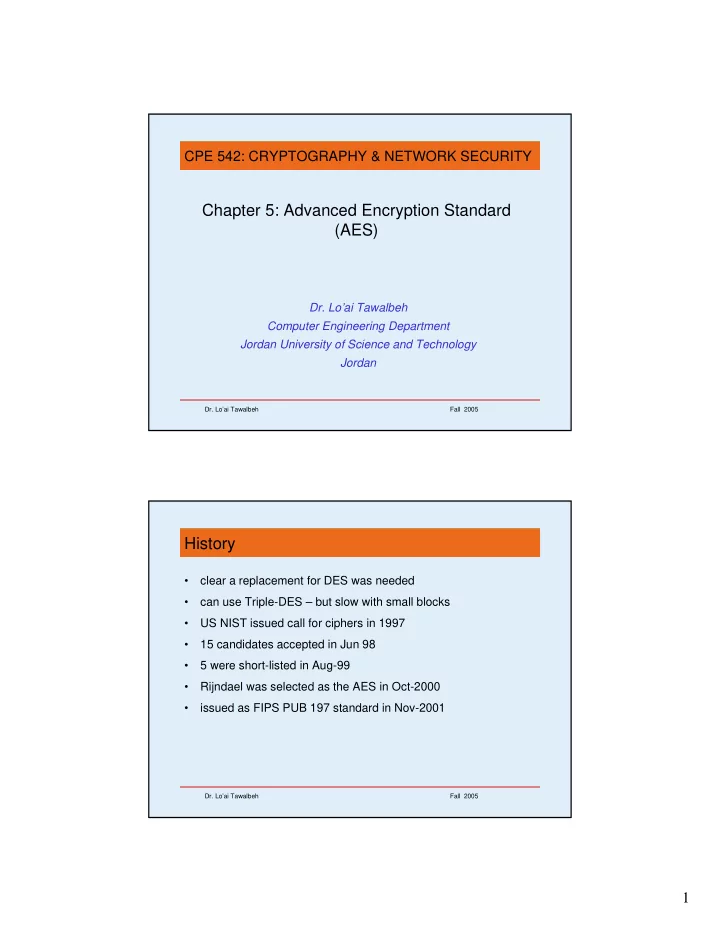

CPE 542: CRYPTOGRAPHY & NETWORK SECURITY Chapter 5: Advanced Encryption Standard (AES) Dr. Lo’ai Tawalbeh Computer Engineering Department Jordan University of Science and Technology Jordan Dr. Lo’ai Tawalbeh Fall 2005 History • clear a replacement for DES was needed • can use Triple-DES – but slow with small blocks • US NIST issued call for ciphers in 1997 • 15 candidates accepted in Jun 98 • 5 were short-listed in Aug-99 • Rijndael was selected as the AES in Oct-2000 • issued as FIPS PUB 197 standard in Nov-2001 Dr. Lo’ai Tawalbeh Fall 2005 1
AES Requirements/Criteria • private key symmetric block cipher • 128-bit data, 128/192/256-bit keys • active life of 20-30 years • both C & Java implementations • criteria • general security • software & hardware implementation ease • implementation attacks • flexibility (in en/decrypt, keying, other factors) Dr. Lo’ai Tawalbeh Fall 2005 The AES Cipher - Rijndael • designed by Rijmen-Daemen in Belgium • has 128 (AES-128), 192 (AES-192), 256(AES-256) bit keys, 128 bit data • an iterative rather than feistel cipher • treats data in 4 groups of 4 bytes • operates an entire block in every round Dr. Lo’ai Tawalbeh Fall 2005 2
(AES) • processes data as 4 groups of 4 bytes (state) • has 10/12/14 rounds (depending o the key length), in each the following operations are performed: • byte substitution (1 S-box used on every byte) • shift rows (permute bytes between groups/columns) • mix columns (subs using matrix multiply of groups) • add round key (XOR state with key material) • all operations can be combined into XOR and table lookups - hence very fast & efficient Dr. Lo’ai Tawalbeh Fall 2005 AES Dr. Lo’ai Tawalbeh Fall 2005 3
Byte Substitution • a simple substitution of each byte • uses one table of 16x16 bytes containing a permutation of all 256 8-bit values • each byte of state is replaced by byte in row (left 4-bits) & column (right 4-bits) • eg. byte {95} is replaced by row 9 col 5 byte • which is the value {2A} • S-box is constructed using a defined transformation of the values in GF(2 8 ) • designed to be resistant to all known attacks Dr. Lo’ai Tawalbeh Fall 2005 Shift Rows • a circular byte shift in each row • 1 st row is unchanged • 2 nd row does 1 byte circular shift to left • 3rd row does 2 byte circular shift to left • 4th row does 3 byte circular shift to left • decrypt does shifts to right Dr. Lo’ai Tawalbeh Fall 2005 4
Mix Columns • each column is processed separately • each byte is replaced by a value dependent on all 4 bytes in the column • effectively a matrix multiplication in GF(2 8 ) using field polynomial m(x) =x 8 +x 4 +x 3 +x+1 Dr. Lo’ai Tawalbeh Fall 2005 Add Round Key • XOR state with 128-bits of the round key • again processed by column (though effectively a series of byte operations) • inverse for decryption is identical since XOR is own inverse, just with correct round key • designed to be as simple as possible Dr. Lo’ai Tawalbeh Fall 2005 5
AES Round Dr. Lo’ai Tawalbeh Fall 2005 AES Key Expansion • takes 128-bit (16-byte) key and expands into array of 44 (AES-128), 52 (AES-192), 60 (AES-256) 32-bit columns • start by copying key into first 4 words • then loop creating words that depend on values in previous & 4 places back • in 3 of 4 cases just XOR these together • every 4 th has S-box + rotate + XOR constant of previous before XOR together • designed to resist known attacks Dr. Lo’ai Tawalbeh Fall 2005 6
AES Decryption • AES decryption is not identical to encryption since steps done in reverse • but can define an equivalent inverse cipher with steps as for encryption • but using inverses of each step • with a different key schedule • works since result is unchanged when • swap byte substitution & shift rows • swap mix columns & add round key Dr. Lo’ai Tawalbeh Fall 2005 Implementation Aspects • can be efficiently implemented on 8-bit CPU • byte substitution works on bytes using a table of 256 entries • shift rows is simple byte shifting • add round key works on byte XORs • mix columns requires matrix multiply in GF(2 8 ) which works on byte values, can be simplified to use a table lookup Dr. Lo’ai Tawalbeh Fall 2005 7
Implementation Aspects • can be efficiently implemented on 32-bit CPU • redefine steps to use 32-bit words • can pre-compute 4 tables of 256-words • then each column in each round can be computed using 4 table lookups + 4 XORs • at a cost of 16Kb to store tables • designers believe this very efficient implementation was a key factor in its selection as the AES cipher Dr. Lo’ai Tawalbeh Fall 2005 Summary • have considered: • the AES selection process • the details of Rijndael – the AES cipher • looked at the steps in each round • the key expansion • implementation aspects Dr. Lo’ai Tawalbeh Fall 2005 8
Recommend
More recommend